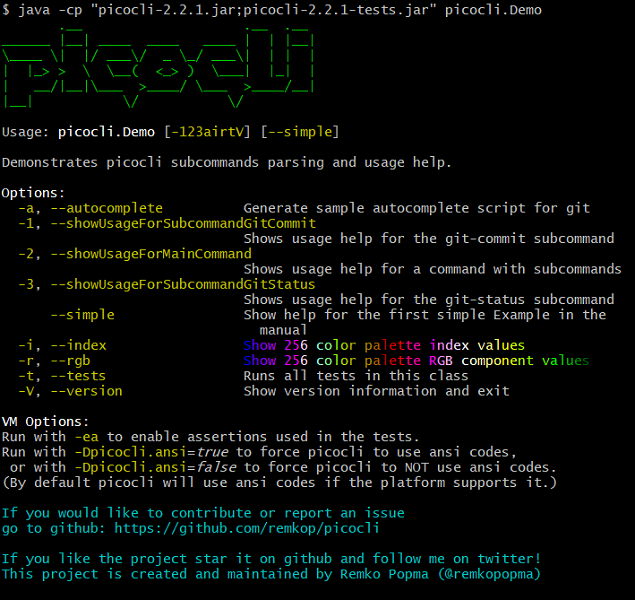picocli - a mighty tiny command line interface
Annotation-based Java command line parser, featuring usage help with ANSI colors, autocomplete and nested subcommands. In a single file, so you can include it in source form. This lets users run picocli-based applications without requiring picocli as an external dependency.
How it works: annotate your class and picocli initializes it from the command line arguments, converting the input to strongly typed data. Supports git-like subcommands (and nested sub-subcommands), any option prefix style, POSIX-style grouped short options, custom type converters and more. Parser tracing facilitates troubleshooting.
Distinguishes between named options and
positional parameters and allows both to be
strongly typed.
Multi-valued fields can specify
an exact number of parameters or a range (e.g., 0..*, 1..2).
Supports Map options like -Dkey1=val1 -Dkey2=val2, where both key and value can be strongly typed.
Generates polished and easily tailored usage help and version help, using ANSI colors where possible. Works with Java 5 or higher (but is designed to facilitate the use of Java 8 lambdas).
Picocli-based command line applications can have TAB autocompletion, interactively showing users what options and subcommands are available.
Releases
- Releases - latest: 2.3.0
- Picocli 2.0 Release Notes - note there are some potential breaking changes from prior versions
Documentation
Articles
Related
- Check out Thibaud Lepretre's picocli Spring boot starter!
Example
Annotate fields with the command line parameter names and description. Optionally implement Runnable or Callable to delegate error handling and requests for usage help or version help to picocli. For example:
import picocli.CommandLine;
import picocli.CommandLine.Option;
import picocli.CommandLine.Parameters;
import java.io.File;
public class Example implements Runnable {
@Option(names = { "-v", "--verbose" }, description = "Verbose mode. Helpful for troubleshooting. " +
"Multiple -v options increase the verbosity.")
private boolean[] verbose = new boolean[0];
@Option(names = { "-h", "--help" }, usageHelp = true,
description = "Displays this help message and quits.")
private boolean helpRequested = false;
@Parameters(arity = "1..*", paramLabel = "FILE", description = "File(s) to process.")
private File[] inputFiles;
public void run() {
if (verbose.length > 0) {
System.out.println(inputFiles.length + " files to process...");
}
if (verbose.length > 1) {
for (File f : inputFiles) {
System.out.println(f.getAbsolutePath());
}
}
}
public static void main(String[] args) {
CommandLine.run(new Example(), System.out, args);
}
}If your command implements Runnable, all the code that is necessary to parse the command line and execute the command is a call to CommandLine.run with the command line parameters and the Runnable command. When the program is run on the command line, the command line arguments are converted to Java objects and assigned to the annotated fields. After the arguments are successfully parsed, picocli calls the command's run method.
$ java Example -v inputFile1 inputFile2
2 files to process...The CommandLine.run convenience method automatically prints the usage help message if the user requested help or when the input was invalid.
If you want more control, you may be interested in the CommandLine.parse or CommandLine.parseWithHandlers methods. See the user manual for details.
Usage Help with ANSI Colors and Styles
Colors, styles, headers, footers and section headings are easily customized with annotations. For example:
See the source code.
Usage Help API
Picocli annotations offer many ways to customize the usage help message.
If annotations are not sufficient, you can use picocli's Help API to customize even further. For example, your application can generate help like this with a custom layout:
See the source code.
Download
You can add picocli as an external dependency to your project, or you can include it as source.
See the source code. Copy and paste it into a file called CommandLine.java, add it to your project, and enjoy!
Gradle
compile 'info.picocli:picocli:2.3.0'
Maven
<dependency>
<groupId>info.picocli</groupId>
<artifactId>picocli</artifactId>
<version>2.3.0</version>
</dependency>
Scala SBT
libraryDependencies += "info.picocli" % "picocli" % "2.3.0"
Ivy
<dependency org="info.picocli" name="picocli" rev="2.3.0" />
Grape
@Grapes(
@Grab(group='info.picocli', module='picocli', version='2.3.0')
)Leiningen
[info.picocli/picocli "2.3.0"]
Buildr
'info.picocli:picocli:jar:2.3.0'






